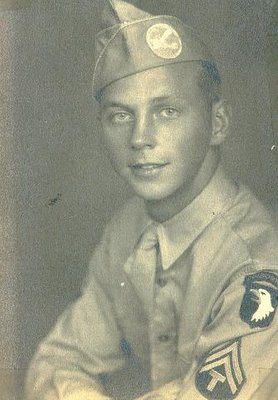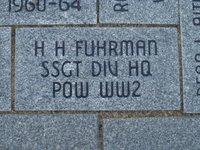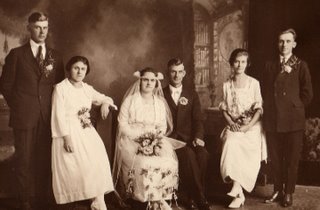[Originally published on November 11, 2011.]
 This handsome young man, who - some say - bears a striking resemblance to his offspring, is being honored this day - Veterans Day - for his service to his country.
This handsome young man, who - some say - bears a striking resemblance to his offspring, is being honored this day - Veterans Day - for his service to his country.
Harold Fuhrman, son of Heinrich and Ida Majeske Fuhrman, joined the United States army in 1942 and became one of the legenday "Screaming Eagles" of the renowned 101st Airborne Division - made famous in both the movie, "Saving Private Ryan," and in the HBO mini-series, "Band of Brothers." The 101st Airborne first saw combat action the night before D-Day, June 5, 1944, just hours before the Allied invasion of Nazi-occupied Europe. The division parachuted and glided into Normandy - northern France - behind German lines with the purpose of disrupting Nazi communications, seizing bridges and vital crossroads, and preventing counterattacks when the naval assault on the Normandy beaches began the next day.
According to military planners, because of the nature of the task before them - night attack, units scattered across the Normandy countryside, powerful German defenses in the immediate area, no support from the naval assault taskforce for at least a day or longer - it was expected that the division would suffer horrendous casualties in the assault. And it did. 1240 men were either killed or wounded in a matter of a few days and a considerable number went missing. Included on the list of missing in action, a dreadfully long list, was the name Harold Fuhrman.
That assault proved to be Harold's one and only combat experience. He was captured near Sainte-Mère-Église, became officially a Prisoner of War, and spent the next year being transferred from one German prison camp to another, all the while losing weight as a result of poor dietary conditions, losing some teeth as a result of unsanitary living conditions (eventually, when he returned to the States, he'd have them all removed), but never losing his American spirit.
Harold Fuhrman was liberated from a hellhole of a prison camp near Küstrin, on the German border with Poland in January of 1945 by the Russian Red Army and, after walking from eastern Germany to the Black Sea in the Crimea, via Warsaw, in order to find transportation home, Harold made his way back to the USA.
After the war ended, like millions of other veterans, Harold Fuhrman returned home and went back to work. He married Lorraine Riehle and eventually raised a fine family - three sons and a daughter.
He rarely spoke of his war experiences. But when he did, the accounts were startling, the details sobering. He once related the story of the death of a soldier near him and the odd sound that a bullet makes when it impacts the human skull. Like a rock thudding into a pool of water.
He also - once - revealed a scar near his knee that resulted from a wound that he sustained in battle, one for which he received no Bronze Star or Purple Heart. No handshake from the President of the United States. No interview with the news media. By the time he made his way back to his unit after being liberated, it had been long healed and - as was the norm in that era - it was a minor wound, one that didn't rise to the level warranting a medal. Those were indeed different times. As Admiral William Halsey said back then, "There are no extraordinary men ... just extraordinary circumstances that ordinary men are forced to deal with." Harold Fuhrman's wound was ordinary - in that extraordinary era - and he thought no more about it. Life went on.
Harold also told the story of his trek across southeast Europe after he was freed from captivity and of his having come upon a field where a battle had taken place sometime previously. The field was strewn with the decaying bodies of German soldiers left to decompose where they lay; the Russians had more important matters at hand than to take the time to bury their dead enemies. It being the dead of winter, Harold stripped the winter coat from one of the corpses and moved on. Such were the times.

Harold Fuhrman lived a long life. A good life. Though he was never recognized for his service to - or particularly his sacrifice for - his country, he was proud of that which he'd been able to contribute. He never asked for recognition. He sought no medals. He considered his enlistment and substantial sacrifices as part of his duty to his country; the country that he held dear every day of his life - one for which he had tremendous gratitude, in which he had terrific pride.

Harold Fuhrman is dead now and buried in a lonely cemetery in rural Indiana. A military marker atop his grave simply reads, "Harold H. Fuhrman, S. Sgt., U.S. Army, WWII." It is as he would have wanted it. Simple. Unassuming. No embroidery. He served his country and that was that.Even though he might have been embarrassed by it, his children decided to honor his service to the United States of America by placing a memorial - one tiny commemoration among thousands of similar remembrances - in the World War II Memorial at Fort Campbell, KY, home to the 101st Airborne Division. It is there for all the world to see and will be there for all time. Without his knowing it then, what he and his fellow soldiers did to preserve freedom for the entire western world has gone down in history. He and they are now honored by a thankful nation - and a loving, respectful family - and will be forever.
Harold Fuhrman's children - Steve, Randy, Suellen, and Jerry - take time out to remember their father this Veterans Day.
- - - - - -
I lifted this photo from a video that's now available on Youtube that was released at the end of World War II by the British press. Included is a Nazi propaganda clip that, at about the 10 second mark, has brief footage of Allied prisoners captured on and around D-Day being marched through the streets of Paris, heading towards POW camps further inland.
The tall soldier at left (circled in red) is my father, Technical Sergeant (T/4) Harold H. Fuhrman, 101st Airborne Division. He appears to be among a group of Canadian, American, and British prisoners being led by armed German guards and officers.
He spent the remainder of the war in prison camps around Germany and was liberated by the Russians in January, 1945.

The video - from British Pathé press - found here -
https://youtu.be/jEvyEM0JdSc
- also shows French civilians spitting on, and slapping those same prisoners as they passed through the crowd. The same French civilians who cheered the American liberators just months later (...).
- - - - -
Harold Fuhrman, over the next seven months was imprisoned in at least three different German POW camps, ending up in Stalag III-C near Alt-Drewitz (now part of Poland). He was captured with his bazooka teammate, Sgt. Kenneth Gamble, also of the 101st Airborne, also assigned to Division HQ sometime before D-Day.
Both being non-commissioned officers they were imprisoned together throughout their incarceration, separate from commissioned officers and from those of lesser rank.
This is the personnel card (Personalkarte) filled out by the Wehrmacht overseers at camp upon Gamble's arrival at Stalag III-A, near Luckenwalde. Their final encampment - III-C - was reserved for non-comms.
Just days after returning from the war Dad was invited to the Rotary Club in Shawano, Wisconsin to tell the members there of his captivity. The article above describes his visit.
"SHAWANO, WIS -- American and British prisoners are treated better than the Russians. T/4 Harold Fuhrman, son of Mr. and Mrs. Henry Fuhrman, Shawano, repatriated German prisoner, told the Shawano Rotary at the Monday meeting.
Prisoners had enough food to subsist on, most of which came through the Red Cross, he revealed. Most of the atrocities reported occurred at concentration camps where political prisoners were kept, but British and American war prisoners were treated as well as the Germans were able, he said.
- - - - - - - -
This is the sort of thing no parent or loved one ever wanted to receive. Dated June 23, 1944, it's an announcement to my grandparents in Bowler, Wisconsin from the U.S. War Department that Technical Sergeant Harold Fuhrman was missing in action, presumed captured, having last been seen boarding a glider with other 101st Airborne Division personnel and heading toward Normandy, France the night before D-Day - June 6, 1944.
- - - - -
The manifest showing those on board the Horsa glider that landed in Normandy. Besides the pilot and co-pilot, these would have been 101st Division staff on board.
- - - - -
Information on the glider pilot - Remington M. Ketcham - and the landing (from the American Air Museum):
"Glider pilot, piloted Horsa glider with 8 x 101st Airborne troops crash landing, struck tree damaging the fuselage and wing of Horsa, vacated A/C into nearby wood followed closely by enemy troops, captured
POW, initially to Gulag Luft 6-Jun-44. Returned To Duty RTD.
"Also listed as a Private in the 303rd Bomb Group. Service number 12040420. O
"Awards: POW, WWII Victory, EAME."
- - - - -
There were eight on board. Here is information about one of them: Lt. Alfred Fratzke: "He entered the Army in August of 1941. During World War II, he served as a first lieutenant with the 1st Infantry Division and was a photo interpreter for Army Intelligence. He served in Africa and Sicily for a year before returning to England to participate in the D-Day Invasion on June 6, 1944. He was wounded and captured by the Germans and was a POW for ten months. He was a Purple Heart recipient."
- - - - -
A photo of 1st Lt. Gerhard Baum, a German Jewish immigrant who was on board.

From his obituary:
Gerhard (Gary) Baum was born 23 JUN 1917 a German Jew in Dortmund, North Rhine-Westphalia, Germany and immigrated to the U. S. with his brother in 1934. He settled in Fort Worth. It might be said that two packs of Lucky Strikes saved Gary Baum.
But more than the smokes, it was his wits.
Mr. Baum, a German-born Jew who had fled to the U.S. during the rise of Adolph Hitler, found himself a prisoner of war on D-Day, wearing the uniform of the Screaming Eagles of the 101st Airborne.
"If they found out he was German and Jewish, he knew they'd kill him," his friend, Jack Gerrick, recalled.
So Mr. Baum sidled up to an old guard at the holding camp in France, after landing in German hands on June 6, 1944, and persuaded the guard to take him out of the interrogation line. The Lucky Strikes sealed the deal.
Mr. Baum survived the war and a grim POW camp to live out a long and full life that ended only this week.
A wisecracking, food-loving man with a strict sense of orderliness, Mr. Baum died early Wednesday morning at Baylor All Saints Medical Center in Fort Worth. He was being treated for cancer of the tongue.
"That German mentality, call it arrogance if you want, came out, and he told everyone that he was going," said his son, Dennis Baum. "Some of us were telling him that he could get better. But he had this look like 'Don't mess with me. Don't waste my time.' He died so peacefully."
Born June 23, 1917, during World War I, Mr. Baum was 15 years old when his father sent him and his brother out of Germany. Not long afterward, Mr. Baum's sister and parents fled.
Hitler became chancellor in January 1933, and Mr. Baum's father felt he knew which way his homeland was going for Jews. History bore out his good judgment.
"He was way ahead of the curve," said Dennis Baum of Dallas. "There were people who said that Hitler was just a crackpot and not to worry. But he said, 'I'm going to send my two boys to the United States to establish citizenship.' He had a tremendous amount of foresight."
When war broke out, Mr. Baum joined the Army, went to officers' candidate school and was assigned as an intelligence officer with the 101st Airborne Division.
"His motivation was one of demonstrating, both to himself and anybody who had any question about it, that he was an American, first and foremost," his son said.
On the day of the Normandy invasion, he was captured before he could even exit the glider that landed in a water-filled ditch. He ended the war in a POW camp in eastern Germany, where he stayed quiet as much as possible. While there he continued acting as an intelligence officer, reporting to the other prisoners what the German guards were saying.
The camp was eventually liberated by Soviet soldiers.
"He said he was always under such stress that someone would let it slip that he was from Germany," Gerrick said.
- - - - -
Baum's story.
- - - - -
The Horsa glider - HG-915 - in the field near Ste. Mere Eglis, France. Note the damaged wing from hitting a tree upon landing. The glider's fuselage was designed to be disassembled into two sections as its seen here. This allowed the craft to carry a jeep or small artillery piece, for ease of off-loading. HG-915 carried one jeep and eight passengers and crew. The ramps shown were used to extricate the jeep after landing, probably by the Germans.
- - - - -
This account of the prisoners' liberation by the Red Army comes from Sergeant Gordon B. Pack, USA, January 31, 1945:
"Soon, long columns of prisoners were threading their way along the snow filled road. Some pushing, some pulling sleds; others wheelbarrows, wagons and so on to haul their blanket rolls and the few odds and ends they were able to hang on to. Apparently there weren't any definite place it seemed to go to.
"We had been traveling I suppose to the best of my estimation some 40 to 50 minutes, with not a word being spoken along the whole column, when all at once, all hell seemed to break loose up ahead. We were nearing a small village, and there were hails of leaden death streamed towards us. Machine guns were chattering their deadly song, as rifles cracked and bullets whined all around. Soon, the heavy 'boom' of a big gun, then the bursting a shell. Soon another, then another, another. They were all landing in the midst of us. Right where that would do the most damage. Shouts and screams of pain and agony were wrenched from men's lips that were hit by shell fragments and bullets and couldn't get away.
"Words cannot explain the horror and the blood chilling sounds that filled the air. I, myself witnessed a scene I shan't forget. Panic soon had its way, and men began running every which way, skimming across the fields of snow trying to find cover. One minute, I saw a head on a man's shoulder, the next, there was no head. This man kept going 15-20 yards, then fell to the ground a bloody mass of torn flesh and bone.
"During the excitement someone yell out, 'For God's sake, men, keep down!' But that cry had been better if not uttered.
"It only seemed to prompt them on. Half of us did manage to stay down, while the rest scattered the fields lining each side of the road. Some were jumping in holes, ditches, sunken places in the ground, behind the few scattered trees that were available. And some were placing their blanket rolls in front of their body for the little protection they offered; which wasn't very much.
"During all of this someone yelled 'Ruskies! Which means 'Russians', the 'Ruskies' are here! Someone make a flag, waved a handkerchief to show them we are unarmed. This was done by a sergeant by the name of Herman Curley. We all called him Curley for short. As soon as he had it finished, he rose and started toward the Russians which were about 300 yards from us. We were still unrecognizable at that distance. Curley started but never got there. A rifle cracked and he slumped to the ground a pitiful sight still with the flag of surrender in his hand. (This brave act that no other man had attempted to do should by every last one of us be remembered. For to my opinion, it saved our lives though it very near cost him his.)"
It is reported that five POW's were accidentally killed by the Russians that day.
Harold Fuhrman with Ken Gamble stateside after the war. They were sent along with other released POW's to Miami for debriefing and rehabilitation. Both look to have been through considerable hardship.



























